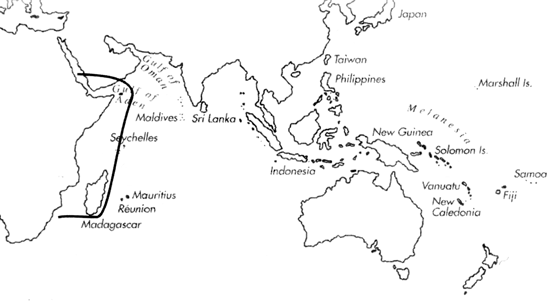Range: C. m. milneedwardsi: Natal to Red Sea; C. m. clytospira: Pakistan to India and Sri Lanka; C. m. lemuriensis: RĂ©union and Mauritius; C. m. kawamurai: Ryukyu Is.
Description: Moderately large to large, moderately solid to solid; specimens smallest in C. m. kawamurai, largest in C. m. milneedwardsi. Last whorl narrowly conical, also conical in C. m. kawamurai and C. m. lemuriensis; outline nearly straight. Depth of exhalent notch about 1/3 to about 2/5 of maximum diameter. Shoulder angulate to sharply angulate. Spire stepped and usually high, also of moderate height in C. m. kawamurai and C. m. lemuriensis; outline generally straight, also variably concave in C. m. kawamurai. Maximum diameter of larval shell about 0.9 mm. First 6-10 postnuclear whorls tuberculate. Teleoconch sutural ramps slightly concave to concave, often less so in C. m. kawamurai, with 0-1 increasing to 4-7 spiral grooves; spiral sculpture may be very weak in latest whorls. Last whorl with variably weak, axially striate spiral grooves near base, separated by ribs at anterior end and by ribbons above; spiral grooves weak or obsolete in C. m. lemuriensis, sometimes extending to shoulder in C. m. milneedwardsi and C. m. clytospira.
| Shell Morphometry | ||
|---|---|---|
| L | 60-174 mm | |
| RW | 0.15-0.53 g/mm | |
| (L 60-110 mm) | ||
| RD | - | |
| (-C. m. milneedwardsi and C. m. clytospira 0.42 - 0.46;-C. m. kawamurai and C. m. lemuriensis 0.46 - 0.54) | ||
| PMD | 0.86-0.94 | |
| RSH | - | |
| (C. m. milneedwardsi and C. m. clytospira 0.28 - 0.33;-C. m. kawamurai 0.20 - 0.31;-C. m. lemuriensis 0.20 - 0.36) | ||
Ground colour white, generally with 2 pink spiral bands on last whorl, just above centre and within basal third; bands most prominent in C. m. clytospira, often weak in C. m. kawamurai; latest sutural ramps sometimes suffused with pink in C. m. milneedwardsi. Last whorl generally with reddish brown reticulated lines forming small to large triangular, quadrangular and round markings, and with similarly coloured triangular spots to variably shaped blotches concentrated in 2-3 spiral bands, within basal third, just above centre and sometimes somewhat below shoulder. Larval shell white to grey. Teleoconch spire matching last whorl in colour pattern. Aperture pink to orangish pink deep within, white to cream in C. m. kawamurai.
Periostracum yellowish grey, thin, translucent, smooth.
C. m. milneedwardsi: Dorsum of foot white, mottled with brown, with a dotted black pre-marginal line latero-posteriorly; brown markings larger and more densely set marginally. Tentacles white. Siphon white, mottled with brown except for distal zone, with a very weak to prominent black ring about 1/4 of the length from the tip; brown mottling may be restricted to the dorso-lateral zones (Liltved & Millard, 1989).
Radular teeth long and slender, with an adapical barb opposite a pronounced blade; long serration ending in a cusp about 1/5 the length from the base; weak basal spur present (Mozambique; Rolán, 1993).
Habitat and Habits: In 50-180 m; C. m. kawamurai known from rocky substrate in about 50 m, C. m. lemuriensis from sand bottoms in 50-60 m.
Discussion: C. milneedwardsi may be similar to C. bengalensis. The latter species has a generally narrower and often narrowly conoid-cylindrical last whorl (RD 0.36-0.46; PMD 0.80-0.96), a less angulate shoulder, a usually lower spire (RSH 0.16-0.24) with fewer tuberculate whorls (4-5 vs. 6-10), and broad axial brown lines within the yellowish brown areas of last whorl and spire. For comparison with superficially similar C. primus, see the Discussion of that species. The nominal species-group taxa C. milneedwardsi, C. clytospira, C. kawamurai and C. lemuriensis may be regarded as geographical forms or subspecies of the same species: C. m. milneedwardsi (Pl. 69, Figs. 5, 6) is the largest form (L 80-174 mm). C. m. clytospira (Pl. 69, Figs. 7, 8) is morphologically very close to the former subspecies, differing in its smaller size (L 65-110 mm) and usually more prominent pink background bands around the last whorl. C. m. lemuriensis (Pl. 69, Fig. 13) is similar in size to C. m. clytospira; it is distinguished from C. m. milneedwardsi and C. m. clytospira by its broader last whorl and its more uniformly reticulated pattern with less numerous and larger white markings, mainly below shoulder. C. m. kawamurai (Pl. 69, Figs. 9-12) is the smallest form (L 60-81 mm), otherwise not separable by shell morphometry from C. m. lemuriensis, and intergrading with C. m. milneedwardsi and C. m. clytospira in shell shape and sculpture except for the broader last whorl. Its last whorl pattern varies from densely to widely meshed and includes sparse brown spots to prominent axially fused spiral colour bands. Pattern varieties of C. m. milneedwardsi, C. m. clytospira and C. m. lemuriensis fall within the range of variation observed in C. m. kawamurai. Whether the recent populations of C. m. kawamurai and the Pleistocene C. aratispira Pilsbry, 1905 from Kikai, Osumi (Japan), are the same species, as considered by Matsukuma, Okutani & Habe, 1991, cannot be unequivocally determined (Walls, [1979], Yoshiba, 1990); similarities in shape are not sufficient to justify such a hypothesis.

C. milneedwardsi range map
This section contains verbatim reproductions of the accounts of 316 species of Conus from the Indo-Pacific region, from Manual of the Living Conidae, by Röckel, Korn and Kohn (1995). They are reproduced with the kind permission of the present publisher, Conchbooks.
All plates and figures referred to in the text are also in Röckel, Korn & Kohn, 1995. Manual of the Living Conidae Vol. 1: Indo-Pacific Region.
The range maps have been modified so that each species account has it own map, rather than one map that showed the ranges of several species in the original work. This was necessary because each species account is on a separate page on the website and not confined to the order of accounts in the book.